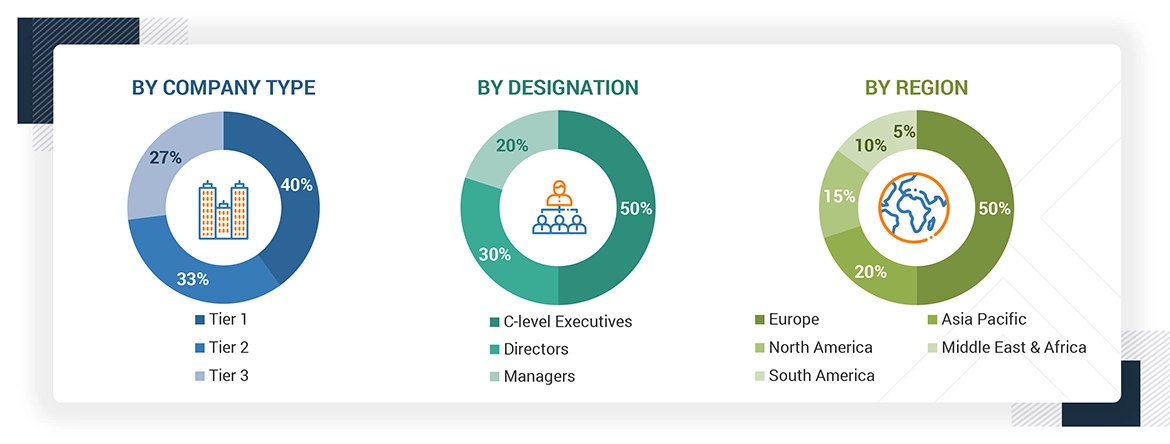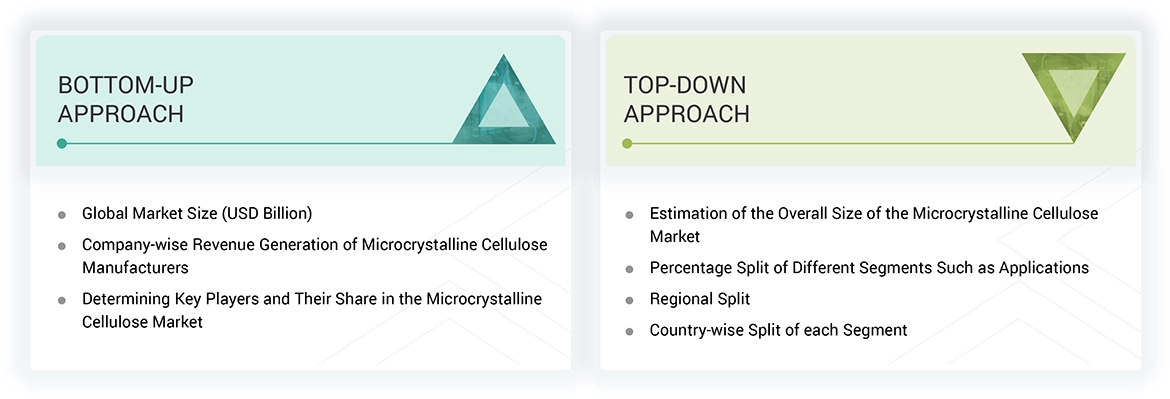The study involves two major activities in estimating the current market size for microcrystalline cellulose market. Exhaustive secondary research was done to collect information on the market, peer market, and parent market. The next step was to validate these findings, assumptions, and sizing with industry experts across the value chain through primary research. Both top-down and bottom-up approaches were employed to estimate the complete market size. After that, market breakdown and data triangulation were used to estimate the market size of segments and subsegments.
Secondary Research
Secondary sources referred to for this research study include financial statements of companies offering microcrystalline cellulose and information from various trade, business, and professional associations. Secondary research has been used to obtain critical information about the industry’s value chain, the total pool of key players, market classification, and segmentation according to industry trends to the bottom-most level and regional markets. The secondary data was collected and analyzed to arrive at the overall size of the microcrystalline cellulose market, which was validated by primary respondents.
Primary Research
Extensive primary research was conducted after obtaining information regarding the microcrystalline cellulose market scenario through secondary research. Several primary interviews were conducted with market experts from both the demand and supply sides across major countries of North America, Europe, Asia Pacific, the Middle East & Africa, and South America. Primary data was collected through questionnaires, emails, and telephonic interviews. The primary sources from the supply side included various industry experts, such as chief experience officers (CXOs), vice presidents (VPs), business development/marketing directors, product development/innovation teams, related key executives from the microcrystalline cellulose industry, system integrators, component providers, distributors, and key opinion leaders. Primary interviews were conducted to gather insights such as market statistics, data on revenue collected from the products and services, market breakdowns, market size estimations, market forecasting, and data triangulation. Primary research also helped in understanding the various trends related to product type, end-use industry, and region. Stakeholders from the demand side, such as CIOs, CTOs, CSOs, and installation teams of the customers/end users who are 3D printing services, were interviewed to understand the buyer’s perspective on the suppliers, products, component providers, and their current usage of microcrystalline cellulose and future outlook of their business which will affect the overall market.
Breakup of Primary Research:

To know about the assumptions considered for the study, download the pdf brochure
Market Size Estimation
The research methodology used to estimate the size of the microcrystalline cellulose market includes the following details. The market size was undertaken from the demand side. The market was upsized based on the demand for microcrystalline cellulose in different applications at the regional level. Such procurements provide information on the demand aspects of the microcrystalline cellulose industry for each end-use industry. For each end-use industry, all possible segments of the microcrystalline cellulose market were integrated and mapped.

Data Triangulation
After arriving at the overall size from the market size estimation process explained above, the total market was split into several segments and subsegments. The data triangulation and market breakdown procedures explained below were implemented, wherever applicable, to complete the overall market engineering process and arrive at the exact statistics for various market segments and subsegments. The data was triangulated by studying various factors and trends from the demand and supply sides. Along with this, the market size was validated using both the top-down and bottom-up approaches.
Market Definition
Microcrystalline cellulose is a partially depolymerized alpha cellulose obtained from purified pulp, which is derived from wood or non-wood cellulose rich natural resource. It is a white, odorless, chemically inert, tasteless, free-flowing powder that is insoluble in water. As it is chemically inert and not absorbed in the human body, it is widely used in the pharmaceutical and food & beverage applications as a thickener, stabilizer, binder, dispersant, and bulking & anti-caking agent.
Microcrystalline cellulose has a high water-holding capacity, helping retain moisture in breads, cakes, cookies, sauces, and dressings, thus extending shelf life and improving product quality. It controls syneresis (water separation) in gels and reduces stickiness in candies and chocolates. Microcrystalline cellulose acts as an emulsion stabilizer in beverages preventing separation and ensuring consistent texture and appearance.
Microcrystalline cellulose is also widely used as an exfoliant and texturizer in cosmetics & personal care industry. Derived from plant cellulose, it appears as a fine powder. In skincare, it serves as a gentle physical exfoliant, helping to remove dead skin cells and promote smoother skin texture. Its small particle size makes it suitable for delicate areas. Microcrystalline cellulose is also utilized as a bulking agent and stabilizer in cosmetic formulations, contributing to product texture and consistency.
Stakeholders
-
microcrystalline Cellulose Manufacturers
-
microcrystalline cellulose Distributors and Suppliers
-
Universities, Governments, and Research Organizations
-
Associations and Industrial Bodies
-
R&D Institutes
-
Environmental Support Agencies
-
Investment Banks and Private Equity Firms
-
Research and Consulting Firms
Report Objectives
-
To define, describe, and forecast the microcrystalline cellulose market size in terms of volume and value
-
To provide detailed information regarding the key factors, such as drivers, restraints, opportunities, and challenges influencing market growth
-
To analyze and project the global microcrystalline cellulose market by source, application, and region.
-
To forecast the market size concerning five main regions (along with country-level data), namely, North America, Europe, Asia Pacific, the Middle East & Africa, and South America, and analyze the significant region-specific trends
-
To strategically analyze micro markets with respect to individual growth trends, prospects, and contributions of the submarkets to the overall market
-
To analyze the market opportunities and the competitive landscape for stakeholders and market leaders
-
To assess recent market developments and competitive strategies, such as agreements, contracts, acquisitions, and product developments/product launches, to draw the competitive landscape
-
To strategically profile the key market players and comprehensively analyze their core competencies



Ravindra
Oct, 2018
Global and India market trends, supply, and regulatory information.
DANIEL
Oct, 2015
Detail analysis and market share on Microcrystalline Cellulose Market by Application and end-use..
DANIEL
Oct, 2015
General information on Microcrystalline Cellulose Market.
soojin
Jan, 2019
Market analysis at global level, market trends, key manufacturers and their key strategies adopted present in the market.
prashant
Jul, 2017
interested in knowing more on cost effective manufacturing process using various raw material sources especially for pharmaceutical usage..
Nishikant
Aug, 2019
Information regarding the market size of Pharma grade MCC..